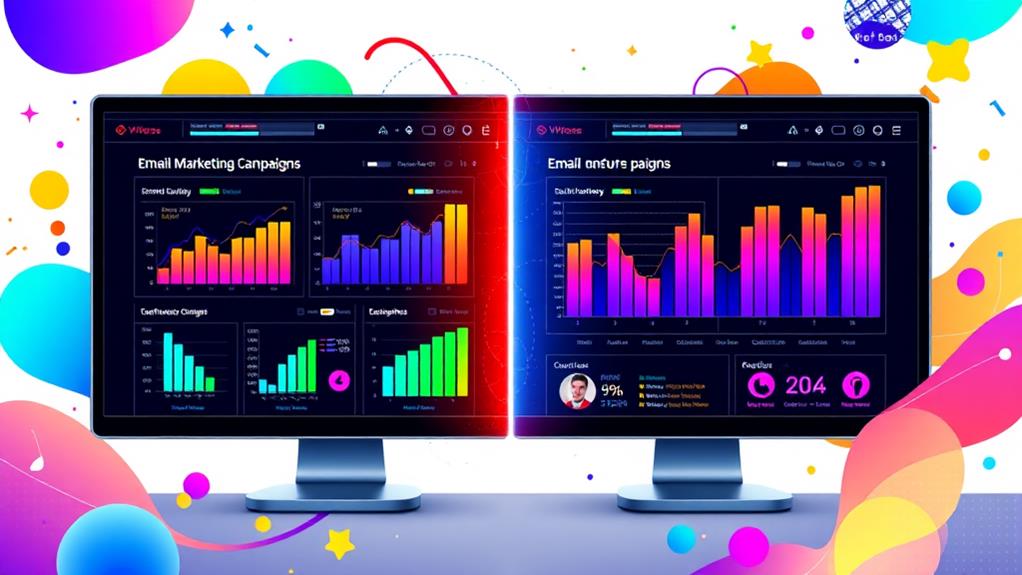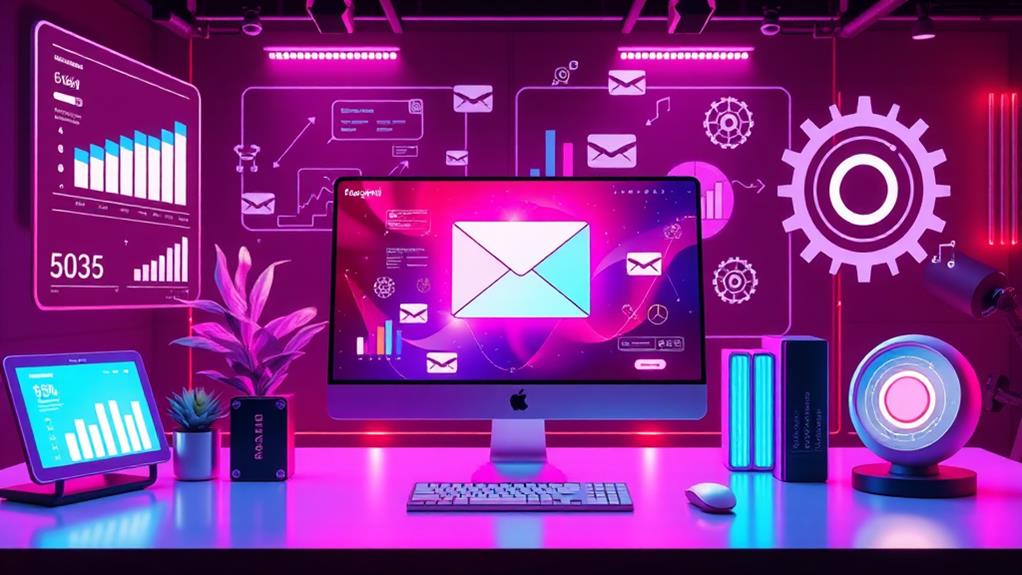Boosting click-through rates in email campaigns hinges on mastering a few key strategies. Craft compelling subject lines with emotional triggers and urgency to grab attention. Personalized content, utilizing dynamic elements like the recipient's name, greatly enhances engagement. Design clear, strategically placed CTAs with bright colors to naturally guide readers to click. Optimize layouts for mobile devices, noting that over 60% of emails are accessed this way. Regular A/B testing provides data-driven insights for refining these elements. Finally, align sending times with audience behaviors to capture peak attention. Explore further techniques to improve your email marketing success.
Key Takeaways
- Craft concise, personalized subject lines for higher open rates and engagement.
- Use dynamic content tailored to subscriber behavior to increase relevance and clicks.
- Design effective CTAs with bright colors and strategic placement for better conversion.
- Optimize emails for mobile devices to enhance readability and click-through rates.
- Conduct A/B testing regularly to refine email elements and improve performance.
Understanding Click-Through Rates
Maneuvering the landscape of email marketing begins with mastering the concept of Click-Through Rates (CTR). This pivotal metric, calculated by dividing the number of clicks by delivered emails and multiplying by 100, reflects how effectively your email content engages recipients.
Understanding CTR benchmarks is essential; the average CTR spans from 2% to 5%, with sectors like education and nonprofits achieving slightly higher rates. A CTR exceeding 7% signals exceptional engagement, underscoring the relevance and appeal of your emails.
To enhance your CTR, audience segmentation is key. By tailoring content to specific demographic or behavioral groups, marketers can deliver more relevant messages that resonate with recipients. This approach not only boosts engagement but also increases the likelihood of clicks.
Additionally, optimizing email design and ensuring mobile compatibility are critical steps. Optimized emails can boost CTR by up to 15%, demonstrating the importance of a user-friendly experience.
Regular analysis of CTR allows marketers to evaluate campaign effectiveness and pinpoint improvement opportunities. By focusing on these strategies, businesses can refine their email marketing efforts, ultimately driving higher engagement and conversion rates.
Mastery of CTR is a cornerstone in achieving email marketing success.
Crafting Engaging Subject Lines
While the body of your email holds valuable content, it is the subject line that first captures your audience's attention. Crafting engaging subject lines is an essential strategy to enhance open rates and, subsequently, click-through rates. Compelling subject lines leverage emotional triggers and urgency tactics to spark curiosity and prompt action. By incorporating phrases like "limited time offer" or "last chance," you stimulate a sense of urgency, encouraging recipients to engage immediately.
Furthermore, concise subject lines are vital; with 47% of recipients deciding to open emails based on subject line length, keeping it between 6-10 words is ideal. Personalized subject lines can greatly impact open rates, with a 26% higher chance of being opened compared to generic ones. This personalization can be paired with actionable language such as "discover," "join," or "get started," which nudges subscribers towards engagement.
Testing is key; A/B testing different subject lines allows you to identify the most effective wording and style for your audience, leading to improved engagement.
Personalizing Email Content
Personalizing email content is a powerful strategy to boost engagement and build stronger connections with your audience. By leveraging dynamic content, you can tailor each email to resonate with individual subscribers, markedly increasing click-through rates (CTR). Including the recipient's name in the subject line alone can raise open rates by 26%, setting the stage for increased interaction with your content.
Recipient segmentation plays an essential role in crafting personalized emails. By dividing your audience into specific groups based on demographics or past behavior, you guarantee that each segment receives content that is relevant to them. This targeted approach can improve CTR by up to 14%, providing a more meaningful experience for recipients.
Tailoring content to reflect past purchases or browsing behavior can further boost engagement, leading to a 20% increase in clicks on embedded links. Additionally, personalized recommendations based on subscriber interests can enhance user experience, increasing CTR by 10% or more.
Moreover, sending birthday or anniversary emails with custom offers taps into the emotional connection with recipients, achieving CTRs of 3-4 times higher than standard promotions.
Designing Effective CTAs
Building upon the power of personalization, the design of effective calls-to-action (CTAs) is vital to converting engagement into measurable outcomes. A strategically positioned CTA, especially on the left side of an email, can greatly enhance click-through rates. This placement, coupled with a well-thought-out button design, can make CTAs more visually appealing and easier to interact with, boosting CTR by 28%.
Color psychology plays an essential role in designing CTAs. Utilizing bright, contrasting colors for buttons can capture attention and drive engagement. For instance, a red button on a white background can stand out and invite clicks more readily than a color scheme with low contrast.
| Strategy | Impact on CTR | Key Consideration |
|---|---|---|
| Left-side Position | Higher CTR | Strategic Placement |
| Button Design | +28% Increase | Visual Appeal |
| Contrasting Colors | Higher Engagement | Color Psychology |
| Single CTA | +42% Increase | Focus and Clarity |
Emails with a single, clear CTA can increase CTR by 42%, highlighting the importance of focus. Additionally, A/B testing is invaluable to refine CTA formats and language, uncovering the most effective strategies tailored to your audience's preferences. With these insights, your CTAs can become powerful drivers of conversion.
Optimizing for Mobile Devices
In the fast-paced digital world, your email's effectiveness hinges on its mobile optimization. With over 60% of emails being opened on mobile devices, the importance of mobile design cannot be overstated. Emails optimized for mobile yield a 15% higher click-through rate, a proof of the power of a well-designed user experience.
A clean and simplified layout is essential; the absence of such leads to 70% of users deleting non-responsive emails, resulting in missed engagement opportunities.
Responsive designs should seamlessly adapt to various screen sizes, ensuring that links and buttons are easily tappable. This not only enhances user experience but also encourages interaction, driving click-through rates.
Testing emails across multiple devices before sending them out is vital. This practice helps identify any potential design issues, guaranteeing ideal readability and functionality for mobile users.
Incorporating these strategies into your email campaigns can greatly improve engagement metrics. The modern user demands convenience and efficiency, and an email that embraces mobile design meets these expectations.
Utilizing A/B Testing
To consistently boost the performance of your email campaigns, employing A/B testing is a strategic necessity. By comparing two versions of an email, you can pinpoint which elements drive higher engagement, specifically in open rates and click-through rates (CTR). Marketers leveraging A/B test strategies have reported an impressive 20% increase in CTR, emphasizing the power of data-driven refinements.
The key to effective A/B testing lies in variable measurement. Testing different subject lines can uncover phrases or words that enhance open rates by up to 30%, providing valuable insights into your audience's preferences.
To harness these benefits, focus on one variable at a time—such as the placement or color of a call-to-action (CTA)—to accurately gauge its impact. This targeted approach guarantees that any changes in engagement metrics are directly attributable to the variable being tested, allowing for precise optimization.
Continuous A/B testing is not a one-time task but an ongoing process. By refining your strategies based on real data, you create a cycle of continuous improvement, leading to sustained boosts in email performance.
Ultimately, A/B testing empowers marketers to make informed, data-driven decisions that enhance the effectiveness of their email campaigns.
Timing Your Email Campaigns
To maximize the effectiveness of your email campaigns, understanding the ideal timing for sending emails is essential.
Research shows that emails sent on Mondays and Tuesdays often achieve higher click-through rates, with peak engagement occurring in the early morning and early evening.
Optimal Send Times
Crafting the perfect email campaign involves more than just compelling content; timing is essential for maximizing engagement. Understanding subscriber behavior and engagement patterns can greatly enhance your campaign's effectiveness.
Research indicates that emails sent on Mondays and Tuesdays often achieve higher click-through rates, as these days typically see increased engagement compared to others. In addition, targeting peak engagement times, such as 6 AM and 6 PM, can further boost your campaign's success. Notable activity also occurs between 11 AM and 2 PM, providing additional windows for ideal delivery.
To refine your timing strategy, consider A/B testing various send times. This approach allows you to gather valuable insights into when your audience is most responsive, enabling you to tailor your timing for maximum impact. By analyzing the results of these tests, you can pinpoint the precise moments your subscribers are most likely to engage with your content.
Ultimately, the key to enhancing send times lies in understanding your audience's unique patterns and adapting your strategy accordingly. By doing so, you guarantee your emails reach subscribers when they are most receptive, thereby enhancing engagement and improving click-through rates.
Frequency and Engagement
A successful email campaign hinges not only on content but also on the strategic timing of your messages. Understanding when your audience is most receptive is essential. Monday and Tuesday are prime days for email engagement, offering higher click-through rates (CTR) compared to the typically less effective Saturdays.
To optimize engagement, aim to send emails during peak times, such as 6 AM or 6 PM, and capitalize on active windows between 11 AM and 2 PM.
To enhance your campaign's effectiveness, leverage email segmentation and audience targeting. This approach helps tailor your messaging to specific groups, ensuring that content resonates with recipients' interests and preferences.
However, even the most precisely targeted emails can suffer from poor timing. As a result, carefully managing email frequency is essential to prevent subscriber fatigue. Sending emails too often can lead to decreased engagement and increased unsubscribe rates.
Experimenting with different sending frequencies is important. Regularly testing and adjusting your approach will help you discover the sweet spot that maximizes engagement and CTR.
Additionally, continuous monitoring of engagement rates allows for timely adjustments, ensuring your emails are delivered when your audience is most likely to engage.
Frequently Asked Questions
How to Improve Click-Through Rate on Email?
Improving email click-through rates involves employing email segmentation to target specific audience interests, and subject line optimization to capture attention. These strategies guarantee relevance and engagement, ultimately guiding recipients towards desired actions and enhancing overall campaign success.
What Is an Example of a Click-Through Rate Email?
An exemplary click-through rate email leverages email segmentation to deliver personalized content, employs strong subject lines to elicit curiosity, and integrates a compelling call-to-action, maximizing engagement and prompting immediate recipient interaction for ideal results.
How to Write a Compelling Email Copy?
To craft compelling email copy, employ engaging subject lines to capture attention and utilize persuasive calls to action. Personalize messages, integrate visuals strategically, and maintain clarity to enhance reader engagement and drive click-through rates effectively.
How to Get a Higher Click-Through Rate?
Achieving a higher click-through rate involves crafting compelling subject lines and implementing audience segmentation. Personalization, clear calls-to-action, and strategic timing also play vital roles in engaging recipients and driving increased interaction with email content.
Conclusion
In summary, enhancing click-through rates in email marketing necessitates a thorough approach that includes understanding the underlying metrics, crafting compelling subject lines, personalizing content, and designing effective calls to action. Optimizing emails for mobile devices and employing A/B testing further refine strategies, while strategic timing of campaigns guarantees maximum engagement. By integrating these elements, marketers can greatly boost the effectiveness of their email campaigns, driving higher interaction rates and achieving desired outcomes.




